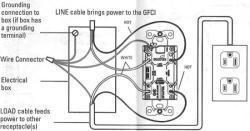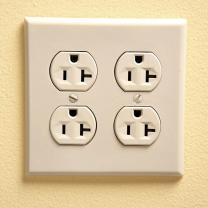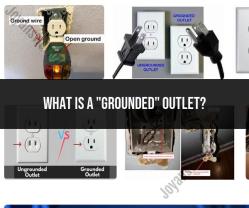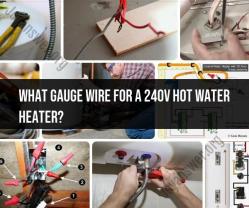How can I properly ground my receptacle box?
Proper grounding is essential for electrical safety. Here are the steps to properly ground a receptacle box:
Materials Needed:
- Grounding wire (usually green or bare copper)
- Screwdriver
- Wire stripper
- Wire nut (if needed)
- Grounding screw (if needed)
Steps:
1. Turn Off Power:
- Before working on any electrical installation, turn off power to the circuit at the breaker box. Use a voltage tester to confirm that the power is off.
2. Check for Grounding Screw:
- Inspect the receptacle box for a pre-installed grounding screw. Some metal boxes come with a threaded hole for this purpose.
3. Prepare Grounding Wire:
- Cut a length of grounding wire. It's typically bare copper or green. Strip about 3/4 inch (1.9 cm) of insulation from each end using a wire stripper.
4. Attach Grounding Wire to Receptacle:
If the receptacle has a grounding screw on its body, wrap one end of the grounding wire around the grounding screw in a clockwise direction. Tighten the screw to secure the wire.
If there is no grounding screw on the receptacle, locate the grounding terminal on the device. Insert the stripped end of the grounding wire into the grounding terminal and tighten the screw.
5. Grounding Clip or Clip to the Box:
If the receptacle box has a grounding clip or tab, ensure that it makes good contact with the metal box. This clip helps establish a connection between the receptacle and the box.
If your box doesn't have a grounding clip, you may need to attach the grounding wire directly to the box.
6. Attach Grounding Wire to Box:
If the receptacle box has a grounding screw hole, wrap the other end of the grounding wire around the grounding screw in a clockwise direction. Tighten the screw securely.
If there is no grounding screw hole, use a grounding clip or another approved method to attach the grounding wire securely to the metal box. Some boxes have a grounding lug specifically designed for this purpose.
7. Wire Nut (if needed):
- If there are multiple grounding wires in the box, you may need to connect them using a wire nut. Twist the ends of the wires together and secure them with a wire nut.
8. Reinstall Receptacle:
- Carefully push the receptacle back into the box, taking care not to pinch or damage the wires. Secure the receptacle to the box using the provided screws.
9. Turn On Power:
- Once the receptacle is installed, turn the power back on at the breaker box. Use a voltage tester to confirm that power is restored.
Note:
Always follow local electrical codes and regulations. If you're unsure about any aspect of the installation, consult with a qualified electrician for guidance. Electrical work should be performed by individuals with the necessary knowledge and expertise to ensure safety and compliance.
What are the steps involved in properly grounding a receptacle box?
Properly grounding a receptacle box is crucial for safety and ensures the proper functioning of electrical circuits. Here are the steps involved:
1. Identify the box type:
- Determine if the box is metal or non-metallic. Grounding methods differ slightly for each type.
2. Locate the grounding screw:
- Metal boxes typically have a pre-drilled hole with a green screw for attaching the grounding wire.
- Non-metallic boxes may require a grounding clip that secures to the box edge.
3. Prepare the grounding wire:
- Strip about 6 inches of insulation from the end of the grounding wire.
- Form a loop at the end of the wire using needle-nose pliers.
4. Connect the grounding wire:
- For metal boxes, insert the bare end of the looped wire under the grounding screw and tighten the screw securely.
- For non-metallic boxes, slide the looped wire onto the grounding clip and snap it shut.
5. Verify connection:
- Ensure the grounding wire is secure and the connection is tight.
- You can use a voltage tester to verify the grounding connection.
6. Install the receptacle:
- Carefully insert the receptacle into the box and secure it with the mounting screws.
- Connect the remaining wires to the appropriate terminals on the receptacle (black to brass, white to silver, and bare copper or green to the green screw).
7. Test the receptacle:
- Once the receptacle is installed, test it with a GFCI tester or a voltage tester to ensure it is working properly.
Additional tips:
- Always turn off the power at the breaker box before working on electrical wiring.
- Use the correct gauge of wire for the circuit.
- Make sure all wire connections are tight and secure.
- Double-check your work before turning the power back on.
- Consult a qualified electrician if you are unsure of any of the steps.
Here are some resources that you may find helpful:
- National Electrical Code (NEC): https://www.nfpa.org/codes-and-standards/7/0/nfpa-70
- Electrical Safety Foundation: https://www.esfi.org/
- Home Depot GFCI Installation Guide: https://videos.homedepot.com/detail/videos/electrical/video/904525910001/how-to-install-gfci-outlets
By following these steps and taking necessary precautions, you can safely and properly ground a receptacle box and ensure the safety and functionality of your electrical system.













